The DeFi Veteran’s 2025 Summer Counterattack and Ecosystem InnovationRecommended Articles
As of now, the total value locked (TVL) in the DeFi market has climbed to $197 billion, just shy of its all-time high of $206 billion. Crucially, this rebound is being led not by newly emerging projects, but by veterans who once enjoyed the glory days of DeFi’s summer.
From its earliest days of speculative demand to its current resurgence, the DeFi market’s collective growth is driven by the accelerated influx of institutional capital (RWAs, compliant lending, and 401(k) 暗号 investments), the resurgence of retail investors’ demand for on-chain returns during the bull market, and the emergence of new use cases driven by technological advancements. The return of veterans is both a reflection of market confidence and the prelude to a new round of DeFi competition.
In this article, BlockBeats summarizes the main reasons for the recent surge in the price and TVL of DeFi “old players” such as Aave, Uniswap, Euler, Pendle, Fluid, and Spark.
AERO: A violent rebound under the support of Coinbase
Aerodrome Finance (AERO) is a decentralized exchange (DEX) launched in 2023 and deployed on the Base chain. It operates as an automated market-making (AMM) model, combining vote-lock governance with a strong liquidity incentive mechanism. Its highly community-friendly design, with an anonymous team, no venture capital investment, and no private placement lock-up, maximizes user benefits. Within just 72 hours of launch, AERO achieved financial TVL exceeding $200 million. In 2024, its total trading volume exceeded $1 billion, with Slipstream contributing 85% of this. By June 2025, AERO’s cumulative trading volume had exceeded $100 billion, firmly establishing itself as a core component of the Base DeFi ecosystem.
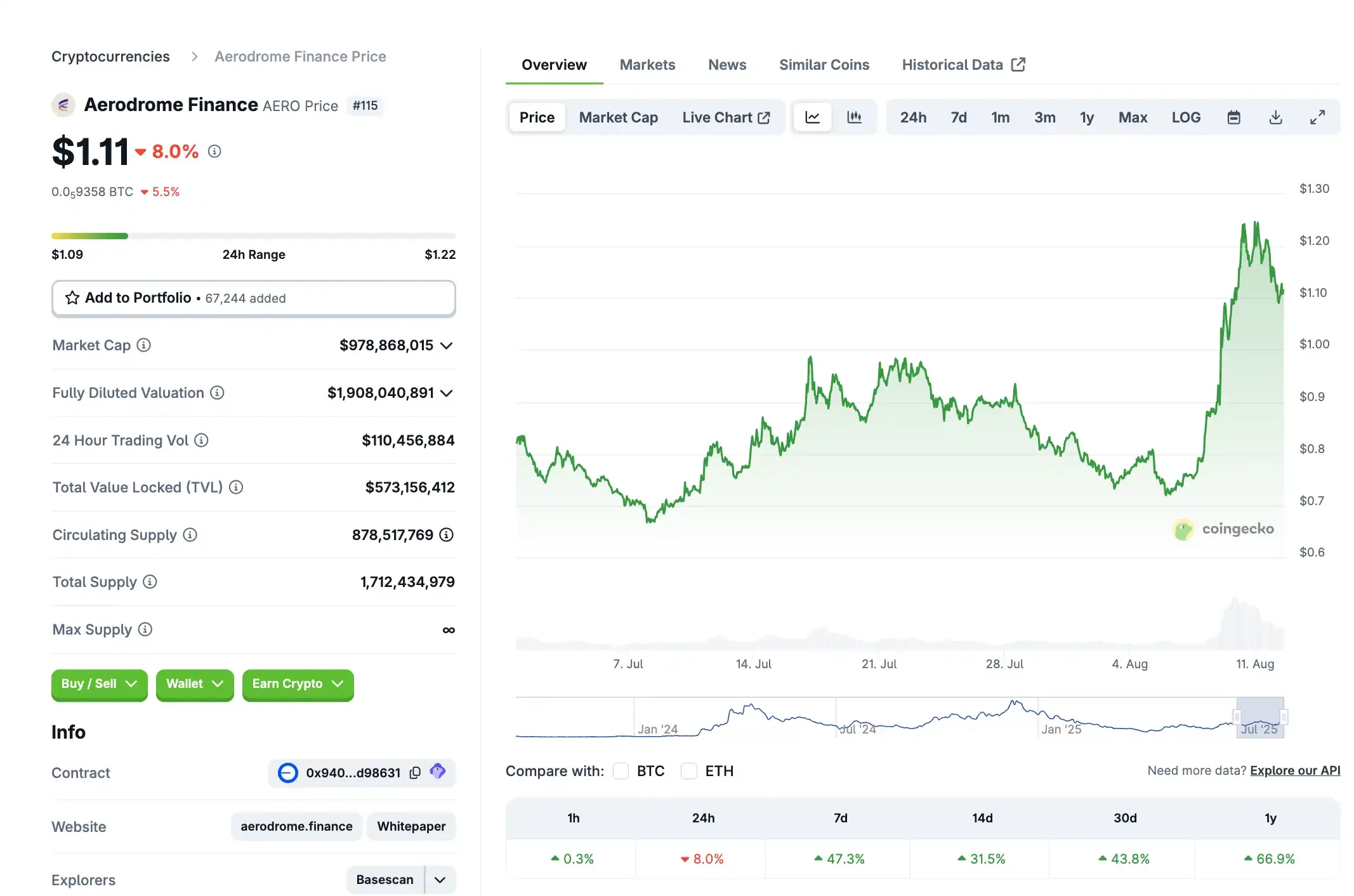
AERO has recently shown strong growth: On August 9th, spurred by the launch of Coinbase’s native DEX feature, AERO’s price surged, reaching $1.23, a 7-day increase of approximately 47%. Its current market capitalization is approximately $978 million, making it a popular project coin.

In addition to Coinbase integrating the DEX trading function of Base native assets into its App, with Aerodrome becoming one of the first supported targets, the reason for AERO’s rise may also be the launch of the “Pool Launcher” tool, which allows projects to create their own liquidity pools and obtain related transaction fees, attracting more Base native projects to join the ecosystem.
Currently, Aerodrome’s TVL is approximately $580 million, almost entirely derived from the Base chain. Its 24-hour DEX trading volume is nearly $950 million, with total trading volume reaching $20.5 billion over the past 30 days. In terms of revenue and investment, Aerodrome’s annualized fee revenue is estimated to be approximately $193 million, with revenue of approximately $15.85 million over the past 30 days. Cumulative incentive expenditures have reached $706 million, demonstrating a strong liquidity incentive orientation.
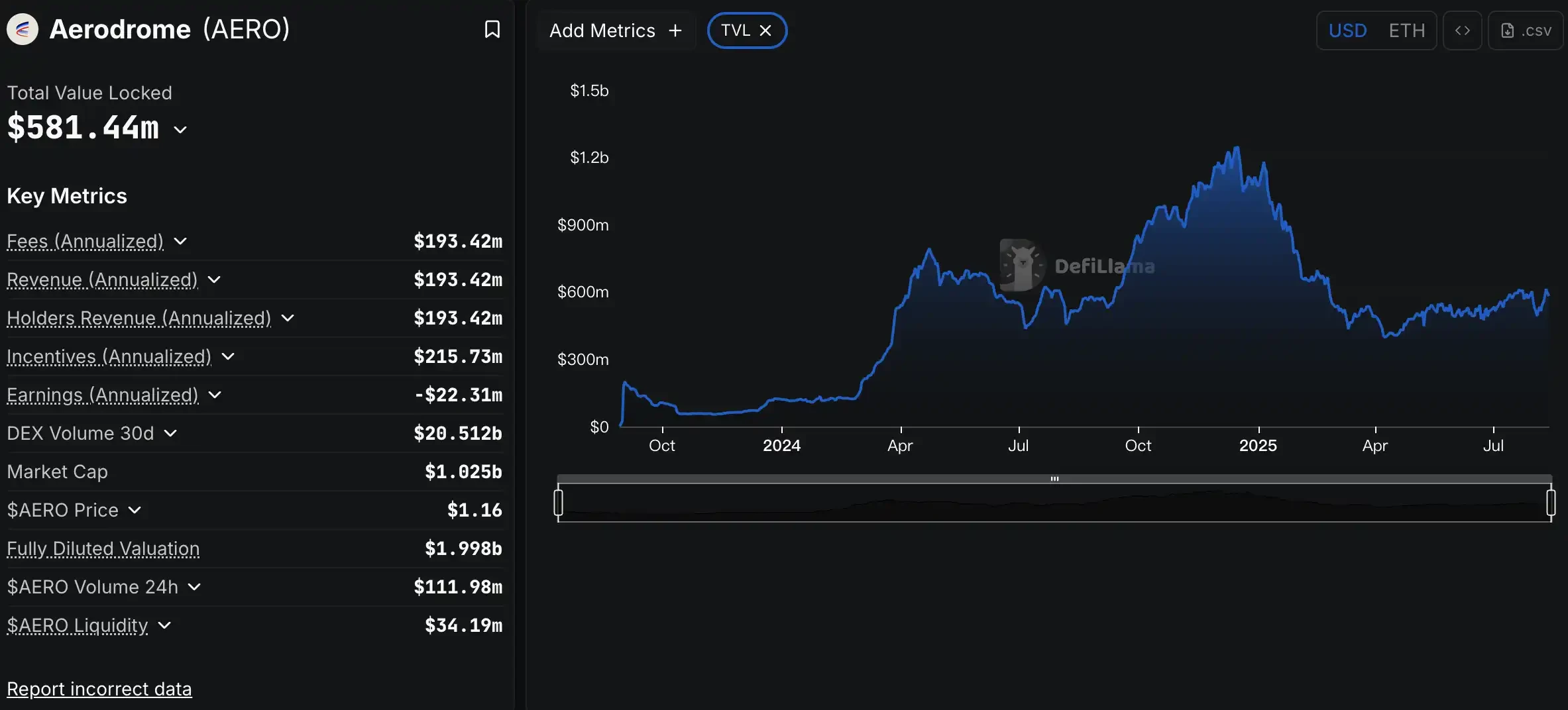
Aerodrome has already established a leading trading and incentive mechanism on the Base chain, becoming a DeFi liquidity hub. The Coinbase integration opened a window to a wider user base and served as the catalyst for a surge in capital and liquidity.
While the upward trend is clear, high incentive spending and overheated technical indicators suggest caution against short-term corrections. In the medium and long term, attention should be paid to the continued expansion of its ecosystem, the implementation of collaborative projects, and whether Coinbase continues to expand its support base. This will determine whether the cryptocurrency can return to its all-time high ($2.32) or break through.
Fluid Flip Uniswap’s ambitions
Fluid is a DeFi protocol that integrates DEX (decentralized exchange), lending, and vault systems, achieving high capital efficiency and liquidity reuse through its innovative Liquidity Layer. Originated from Instadapp and relaunched in 2023, Fluid allows assets to be freely transferred within the Liquidity Layer without multiple lock-ups, significantly reducing fragmentation costs and increasing returns. Its Smart Debt and Smart Collateral models provide improved capital efficiency for both liquidity providers and debtors.
Fluid has recently become a focal point in the DeFi market. On August 4th, Fluid’s daily on-chain transaction volume surpassed Uniswap, reaching approximately $1.5 billion, driving the price of $FLUID up 14.4% that day. As of now, Fluid has risen to $7.38, a 36.1% increase in 7 days and a 51% increase in 30 days.

Fluid’s rise may be driven by the following four factors:
1. Liquidity layer architecture breaks down fragmentation
Fluid is launching on chains like Arbitrum and Solana, with a lighter-weight Lite version and support for DEX v2 upgrades, further improving yields and user reach. Fluid’s Liquidity Layer enables shared liquidity, allowing assets to be locked up once for multiple uses, a key driver of its rapid capital absorption and trading.
2. Transaction share rises rapidly
In the short term, Fluid will surpass Uniswap and grab more than half of the stablecoin trading market share, directly strengthening its dual-wheel drive of ecology and sentiment.
3. Trader confidence is recovering
DEX daily trading volume hit a record high, and token prices rose in the short term, indicating that the market’s recognition of the Fluid model has increased and the efficiency of liquidity allocation has been recognized.
4. Long-term positive expectations for the repurchase mechanism
Officials have made it clear that a buyback will be initiated when annualized revenue reaches US$10 million, which provides medium- and long-term support for the token value and attracts investors to invest at a low price.
The platform’s cumulative transaction volume has exceeded $7.9-$8 billion, with a monthly TVL growth rate of approximately 27%, reaching a total value of approximately $838 million, demonstrating strong capital growth. Since 2025, Fluid’s deposits have increased by nearly 40%, exceeding $1.4 billion. The platform is also developing a multi-chain presence (such as Arbitrum and Solana) and plans for DEX Lite. As of August 3rd, Fluid’s market share for stablecoin swaps on Ethereum, Base, Arbitrum, and Polygon reached 55.5%, far exceeding Uniswap (25.7%) and Curve (13.4%).

Overall, Fluid has become a rising star in DeFi. Leveraging its unique Liquidity Layer, robust transaction data, and multi-chain scaling strategy, the platform has quickly returned to center stage and set a new benchmark for stablecoin trading in DeFi. While its short-term performance has been impressive, several risks remain to be considered. Whether Fluid will experience a short-term correction remains to be seen. Ecosystem adoption and user engagement—and whether subsequent projects can truly build on Fluid’s liquidity layer—are key to continued momentum. If the subsequent DEX v2 and Lite versions successfully launch and drive revenue beyond critical milestones, not only will a buyback mechanism be activated, but user engagement and market valuation will also likely be further enhanced, cementing Fluid’s position as a new benchmark for stablecoin trading.
Uniswap v4 TVL breaks $1 billion again
Uniswap, a veteran in the DeFi world, officially launched its v4 in early 2025. It supports 12 chains, including Ethereum, Arbitrum, Base, Polygon, BNB Chain, and Unichain. It also adds the “Hooks” feature, enabling custom logic such as dynamic fees, on-chain limit orders, and TWAP for liquidity pools. Furthermore, through its Singleton architecture and Flash Accounting technology, it reduces gas costs by over 99%. v4 retains the capital efficiency advantages of v3 while enhancing flexibility and programmability, becoming a crucial piece of innovative DeFi infrastructure.
Uniswap has performed steadily recently: as of now, the price of UNI is $11.27, up about 31% in 30 days, and its market value has returned to the $670 million range.
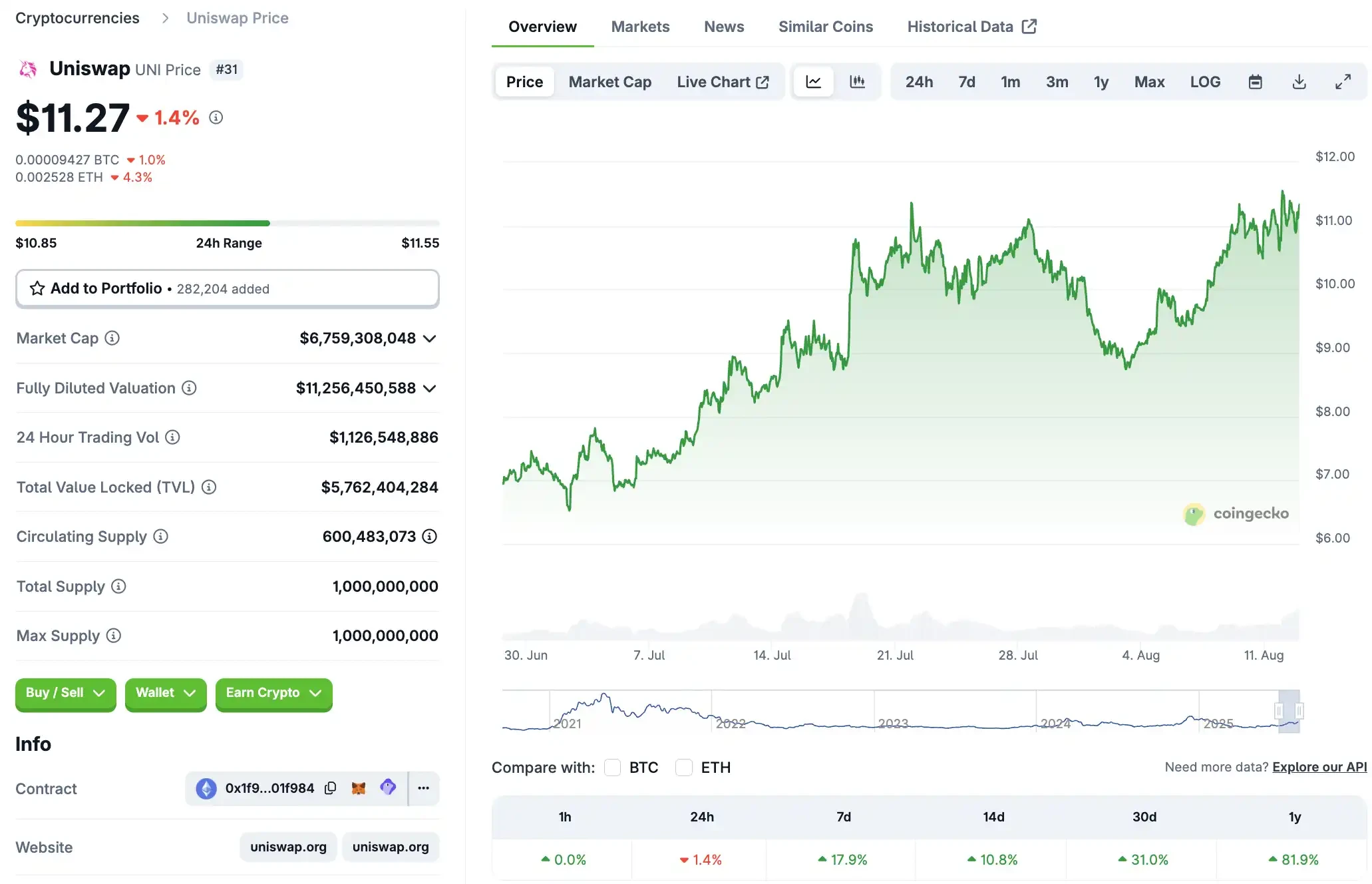
UNI’s upward momentum is driven by:
1. Strong TVL rebound
v 4 broke through $1 B TVL at an astonishing speed, providing solid emotional support for the UNI price and highlighting the recovery trend of the DeFi ecosystem.
2. Hooks innovation attracts capital
Programmable liquidity strategies have led to the rapid rise of various strategic projects (such as Bunni and EulerSwap), promoting user participation and operational depth.
3. Unichain’s role in expansion is prominent
The new network brings lower costs and more efficient experience, creating a new growth engine for Uniswap and further increasing activity.
4. Technological iteration and system upgrade
v 4 introduced smart wallet support, cross-chain integration (such as Hyperbridge, LayerZero) and 640M+ swap transaction volume, building a more three-dimensional trading infrastructure.

Currently, Uniswap v4’s TVL has surpassed the $1 billion milestone. With cumulative trading volume exceeding $11 billion, Uniswap is considered a DeFi liquidity hub. Unichain accounts for approximately 75% of daily trading volume, while Ethereum accounts for approximately 15–20%. Regarding Hooks deployment, over 2,500 Hook liquidity pools have been launched, with Bunni and EulerSwap both exceeding $1 billion in cumulative trading volume.
Despite Fluid’s dazzle in the market, Uniswap remains a solid contender. Its v4 version continues to solidify its core position in DeFi through technological innovation and ecosystem expansion. Rapid growth in TVL and the widespread adoption of Hooks are key foundations for its resurgence. However, technical indicators like the RSI are elevated, suggesting potential short-term profit-taking pressure.
Whether it can continue to rise depends on: whether the Hook strategy pool can bring new growth; whether cross-chain integration can deepen ecological cooperation; and whether Unichain can continue to maintain its cost advantage and attractiveness, and is expected to challenge the $13-$14 range.
Euler: Rebirth from the Ashes after the Hacker Attack
Euler Finance is a modular lending protocol on Ethereum, renowned for its risk stratification, flexible asset licensing, and high capital efficiency. It supports the integration of any ERC-20 asset, manages leveraged positions, and features a sophisticated liquidation protection mechanism. After suffering a significant blow from a 2024 hack, the project quickly regained its trust after a reboot, becoming a key player in the resurgence of the DeFi lending sector.
Recently, $EUL reached a new all-time high, briefly exceeding $15, a surge of over 950% from its low at the end of 2023. Its market capitalization is approaching $300 million. Despite a slight correction, the price is currently stable in the $11.8–$13 range.

Euler’s upward momentum is driven by:
1. Rise from the Ashes
Euler’s rapid restart after the hacking incident, winning the trust of the community and capital inflow, is an important basis for its sharp rebound.
2. TVL and lending depth both rebounded
The abnormal growth of TVL and the surge in active loans reflect strong user lending demand and the recovery of protocol momentum.
3. EulerSwap complements the ecosystem
After launching the native DEX, Euler built a self-circulating liquidity path to achieve a closed-loop linkage between staking, lending and trading.
4. Increased support from mainstream platforms
The latest news indicates that Coinbase will support EUL. After the announcement, the price rose by about 5.7% in one day, reflecting the increasing recognition of the capital market.

Recent data shows Euler’s TVL has reached $1.2 billion, having largely overcome the impact and challenges following the hack. Euler launched its native DEX, EulerSwap, which has surpassed $1 billion in cumulative trading volume since its launch in May. Active loan activity: Active loan amounts recently surpassed $1 billion, a significant increase from approximately $240,000 at the end of 2024.
Euler’s recovery is a typical “rebirth from the ashes” story: it went from the predicament after being hacked to a rapid restart, TVL explosion, product innovation, and then to the gradual restoration of market value and market attention, demonstrating the resilience of old DeFi projects in trust and governance.
However, it’s worth keeping an eye on the potential for a pullback after high prices, as well as EulerSwap’s ability to maintain trading depth and expand its lending offerings. Continued support from more capital platforms, such as Coinbase and the launch of more CEXs, will strengthen its liquidity and market capitalization. If Euler can maintain its TVL growth, lending activity, and DEX development momentum, it’s expected to return to a higher valuation range, continuing its classic story of “rejuvenation.”
Pendle: Boros drives both TVL and price surge
Pendle is a DeFi protocol that allows users to trade future returns. Its core mechanism is to split any yield-generating asset into a “yield” and a “principal,” allowing users to freely trade future returns. Pendle V3 incorporates the Boros platform, creating advanced yield trading tools that have become a core part of yield-trading infrastructure.
Pendle has performed well recently: its price once nearly hit $6, and it has increased by 46% in the past week, far exceeding the overall market trend.
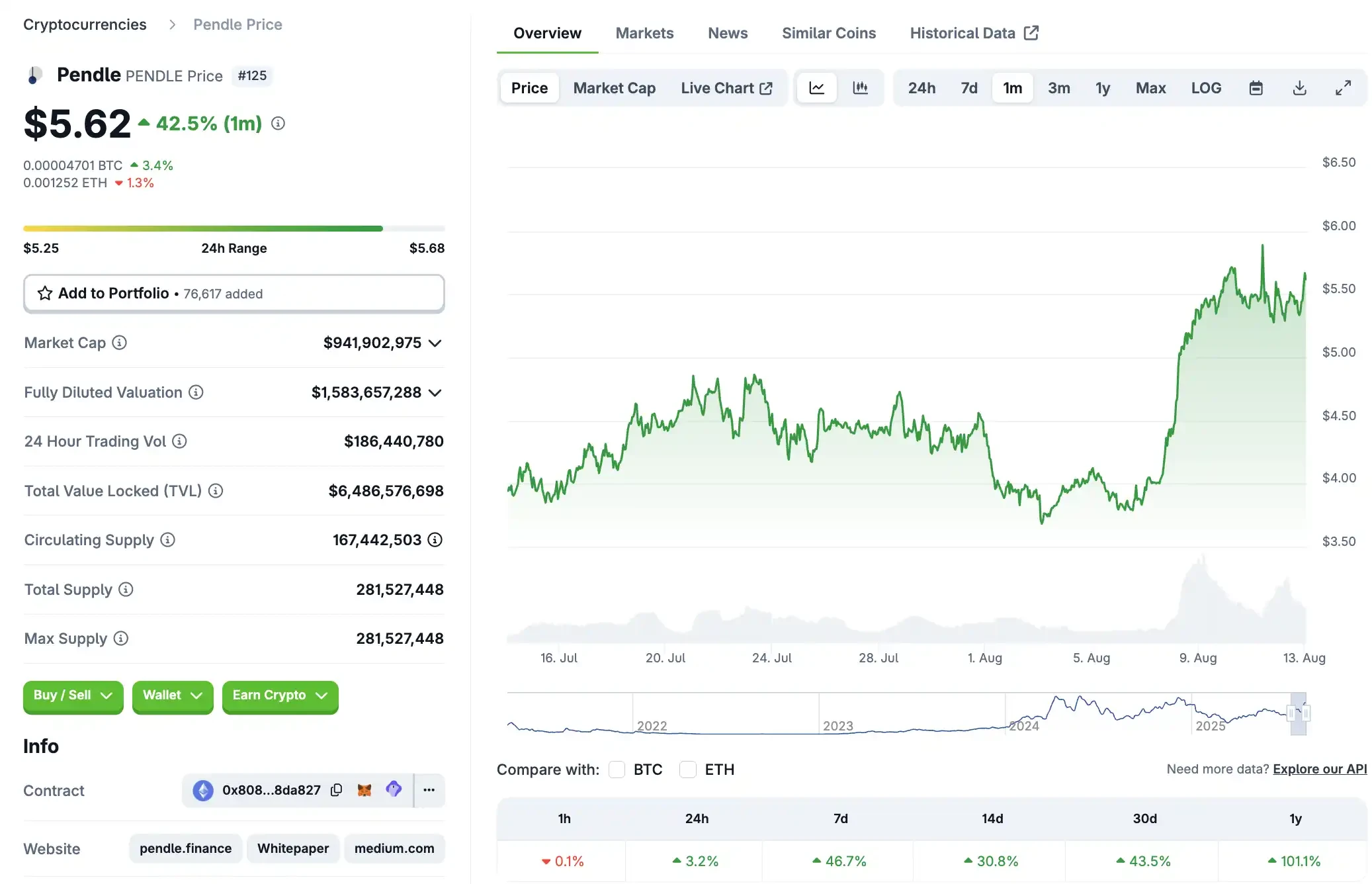
Pendle’s upward momentum is driven by:
1. Boros Engine, a revenue trading platform, launched
After its launch, Boros converted BTC/ETH funding rates into tradable assets (Yield Units), rapidly increasing user engagement and capital inflows.
2. Cross-protocol integration mechanism optimizes capital efficiency
Cross-ecological linkage with Ethena, Aave, and Boros has made Pendle a gathering place for efficient yield strategies, and its PT-USDe strategy has driven an increase in capital scale.
3. TVL and revenue growth bring confidence
The record-high TVL and surging revenue provide strong support for the token and boost market sentiment.

Pendle’s TVL reached a record high of $8.8 billion, driven primarily by a surge in capital generated by the Boros platform. In its first two days, the platform attracted over $1.85 million in BTC and ETH deposits. The number of active addresses on Arbitrum doubled, attracting interest from on-chain and institutional investors.
At the same time, protocol integration is driving a surge in liquidity. Approximately 60% of TVL comes from USDe strategies (such as PT-USDe generating leverage and liquidity on Aave), creating a powerful “yield-loop” asset circulation mechanism.
Pendle is becoming a rising star in DeFi thanks to its unique yield-trading mechanism and protocol integration strategy. The Boros platform has injected strong momentum into the platform, leading to a surge in both TVL and price. However, caution is warranted regarding the risk of a short-term pullback from its technical highs and the concentration risk associated with USDe’s exclusivity. If Pendle can continue to expand Boros-supported assets (such as staking income and Treasury bond yields) and promote deeper integration of overall protocol governance and the ecosystem, it has the potential to consistently challenge the $7-$8 price range, truly ushering in a new chapter for an established project.
Aave becomes the lending king again, becoming more institutionalized
Aave is a leading lending protocol in the DeFi world, renowned for its non-custodial, modular design, and cross-chain support. Its innovative features, including the GHO stablecoin, Umbrella security mechanism, and Aave Arc/Horizon, further solidify its position at the heart of the DeFi liquidity layer.
AAVE has performed well recently: the price hit a high of $330 in mid-July, up about 24% in 7 days. Although there is short-term correction pressure at the high market price, the overall trend is strong.
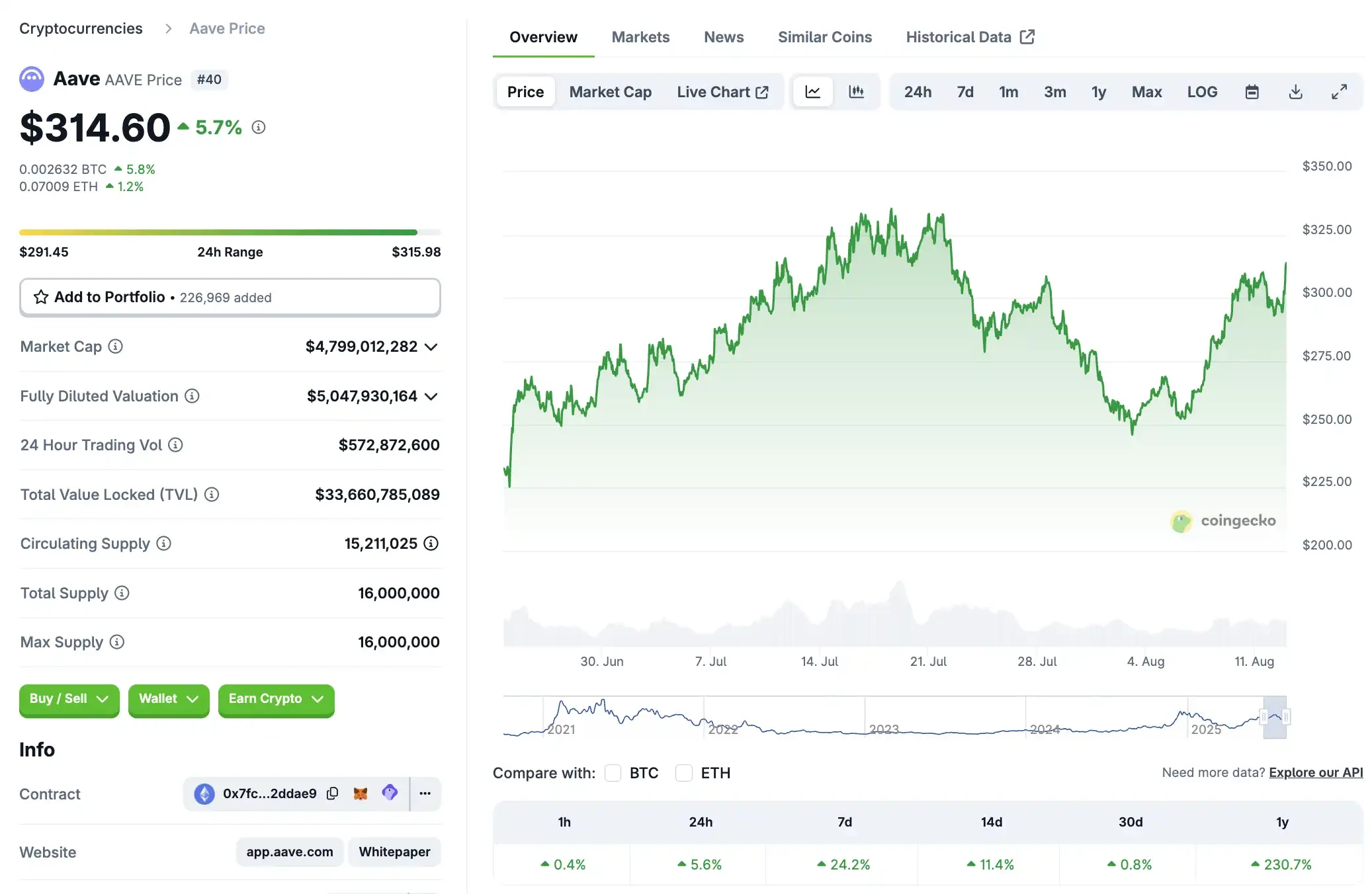
Aave’s upward momentum is driven by:
1. Capital inflow and TVL lead
Aave remains dominant in the lending market, with a continuous influx of new users and funds, providing a solid foundation for market confidence.
2. Stablecoin GHO performance improvement value recognition
GHO’s cross-chain extension, sGHO, anti-GHO and other mechanisms bring multi-layered income incentives to holders and enhance ecological stickiness.
3. Institutional paths continue to be implemented
Horizon, Arc, and KYC compliance mechanisms make Aave an important entry point for institutional-level DeFi lending.
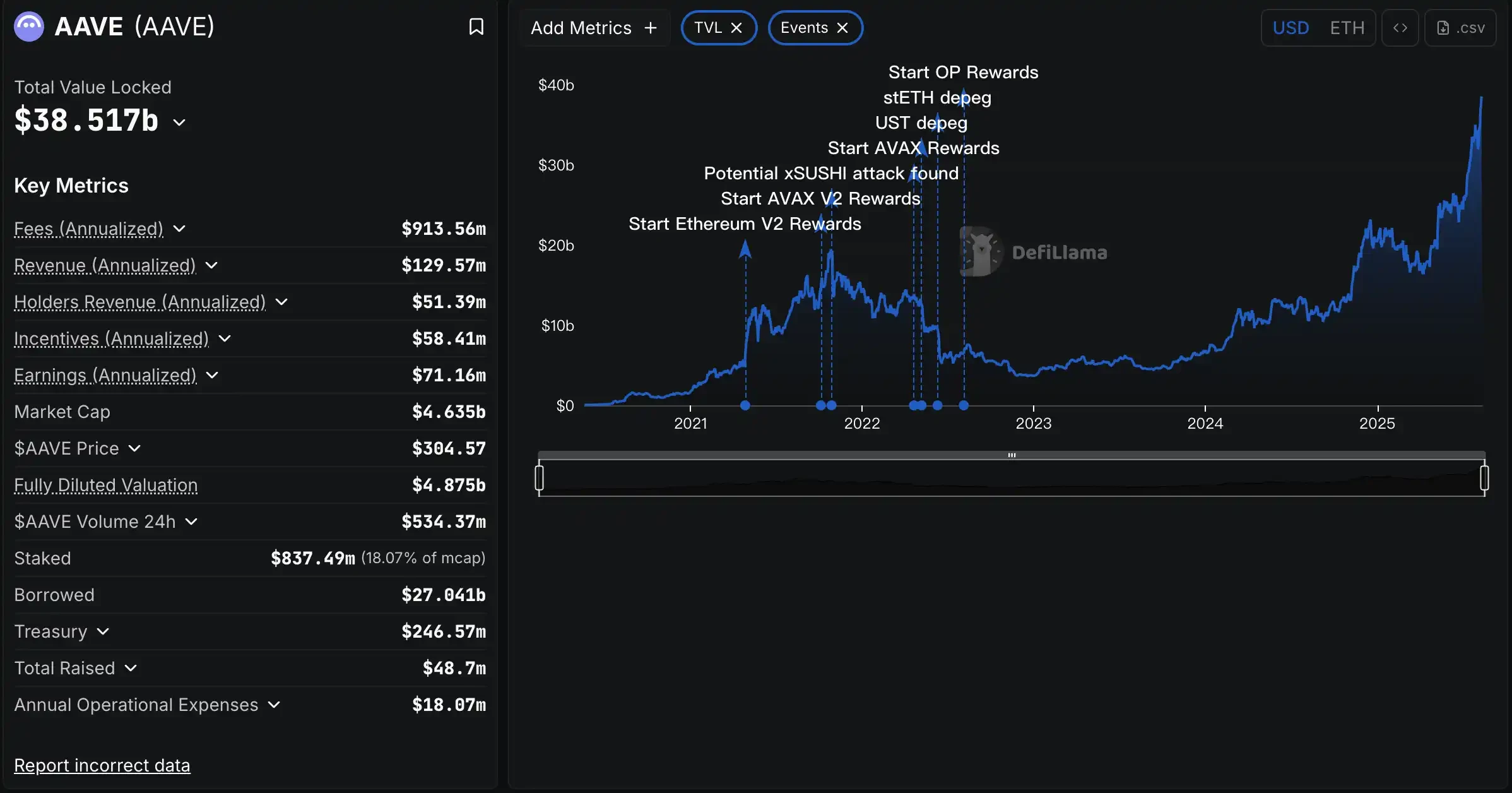
Looking at other key data, Aave’s current TVL has reached $38.04 billion, a 52% increase from the beginning of the year, accounting for nearly a quarter of DeFi’s total TVL and dominating the lending market. Its native stablecoin, GHO, has a circulation of $312 million. GHO’s cross-chain expansion on Arbitrum and Base has driven revenue growth, and AAVE achieved a 22.97% return in its most recent rebalance cycle.
In terms of specific institutional cooperation, Aave launched the Horizon project to promote RWA and institutional usage paths; and cooperated with Plasma to launch a blockchain fund for institutions; Aave DAO also approved a white label solution for the Kraken Ink chain.
Aave, a veteran in the DeFi lending space, remains resilient. Its TVL and deposit size continue to set new records, its GHO functionality continues to expand, and its institutional lending platform is steadily progressing, all fueling its resurgence. However, AAVE’s high price is facing downward pressure, with technical indicators like the RSI approaching overbought levels, suggesting a short-term correction. Whether it can maintain its leadership in the DeFi lending space will depend on the rollout progress of Aave V4, the effectiveness of its RWA channel implementation, and regulatory developments.
Spark: A Sword for MakerDAO
Spark Protocol (Spark), an evolution of MakerDAO and now part of the Sky ecosystem, is an advanced on-chain capital allocator dedicated to efficiently deploying billions of dollars in stablecoin capital into DeFi, CeFi, and real-world assets (RWA). Its core products include SparkLend (lending), Spark Savings (yield generation), and the Spark Liquidity Layer (cross-chain liquidity provisioning).
Since the SPK token was officially airdropped and listed on June 17, 2025, its market performance has been extremely eye-catching: the original TGE issue price was approximately $0.065. In the short term, the SPK price experienced significant fluctuations – from the lowest to less than half of the issue price (approximately $0.03), but then rebounded strongly, reaching a historical high of $0.18 on July 23. This wave of increase exceeded 400%. The current price is stable in the $0.12-$0.13 range, with a market value of nearly $190 million and a 24-hour trading volume of nearly $450 million.

The main reasons for the rise of SPK tokens may be the following four:
1. TVL surge boosts sentiment
Spark’s TVL has skyrocketed by 250% since April. This type of capital injection has directly boosted market confidence, causing SPK prices to quickly rebound and hit an ATH.
2. エアドロップs and listings boost trading
Spark’s launch was accompanied by a large-scale airdrop and listing on major exchanges (such as Binance), and a favorable mechanism was established to boost initial market attention and price volatility.
3. Top-level funding and technical endorsement
Backed by the $6.5 billion stablecoin reserve of the Sky (formerly MakerDAO) platform and a transparent mechanism as the core of capital deployment, Spark has a strong stable foundation.
4. Product structural integrity
Spark has a product matrix covering income generation, lending and cross-chain liquidity, and fully connects user needs through SparkLend, Savings and SLL.
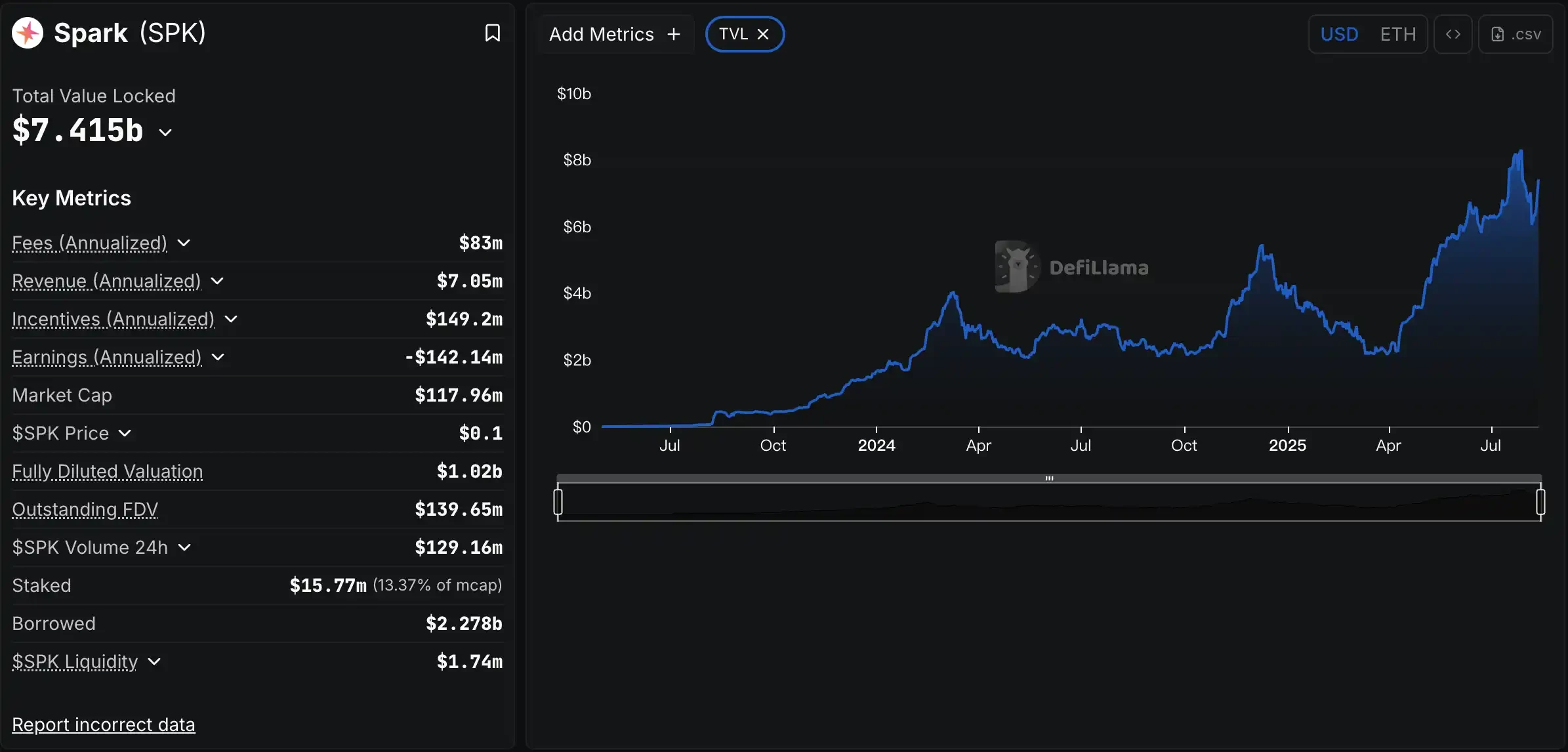
As of this writing, Spark’s total TVL has reached $7.4 billion. Previously, in July, TVL peaked at $8.1 billion, ranking it the sixth-largest DeFi platform. SparkLend manages approximately $4.7 billion, and SLL manages approximately $3.4 billion. Spark is rapidly reshaping the standard for stablecoins and capital efficiency in DeFi. The surge in TVL, the enthusiasm for airdrops, and Sky’s endorsement have enabled SPK to achieve a legendary comeback as a “reborn old project” in a short period of time.
However, high volatility and initial pressure to cash out persist, with prices already down 30–40%. Caution is advised against short-term market corrections. Continued growth will depend on the continued expansion of the Spark ecosystem (e.g., CeFi channels and RWA integration), governance activity, and the loyalty of SPK holders.
この記事はインターネットから得たものです。 The DeFi Veteran’s 2025 Summer Counterattack and Ecosystem InnovationRecommended Articles
Original | Odaily Planet Daily ( @OdailyChina ) Author | Ethan ( @ethanzhang_ウェブ3 ) On June 16, 2025, US President Trump officially announced the launch of his mobile communications brand Trump Mobile , and simultaneously announced its first smartphone T1 and the accompanying The 47 Plan communications package. Trump made a high-profile statement in the release: Trump Mobile will use Made in the USA mobile phones and services, emphasizing that the package will provide roadside assistance, unlimited text messages and other services. The appearance of the T1 mobile phone caused a stir in public opinion. In fact, this is not the first time Trump has been involved in merchandise sales. Previously, he opened a Trump Store on Amazon, selling products including red baseball caps, T-shirts, mugs, etc., with impressive sales…







